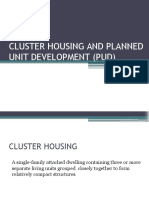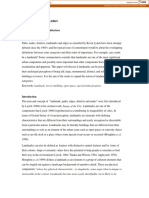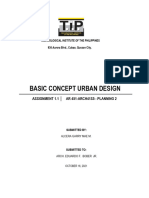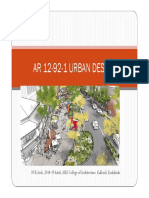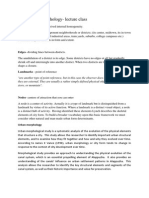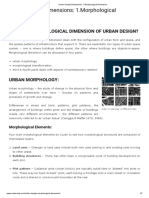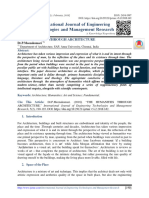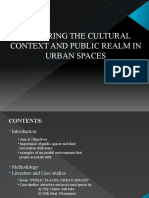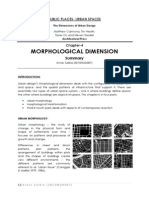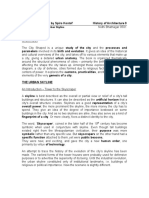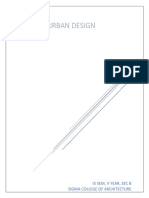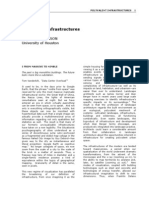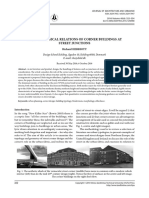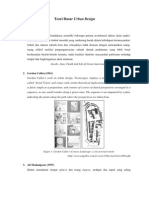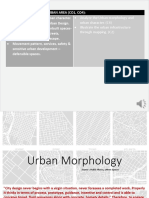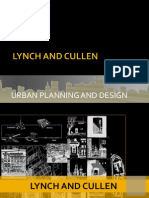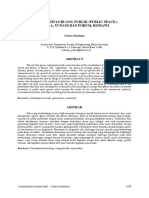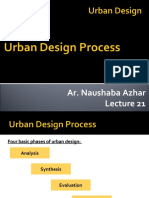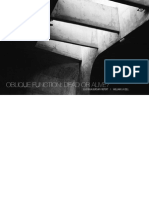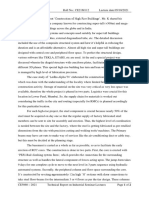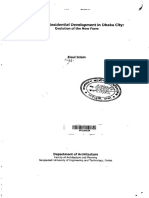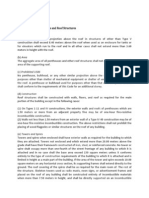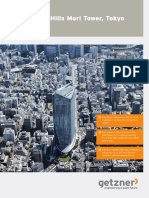Redefining Landmarks
Redefining Landmarks
Uploaded by
Silvia FunieruCopyright:
Available Formats
Redefining Landmarks
Redefining Landmarks
Uploaded by
Silvia FunieruOriginal Description:
Copyright
Available Formats
Share this document
Did you find this document useful?
Is this content inappropriate?
Copyright:
Available Formats
Redefining Landmarks
Redefining Landmarks
Uploaded by
Silvia FunieruCopyright:
Available Formats
REDEFINING LANDMARKS Dr. Hasanuddin Lamit Dept.
Of Landscape Architecture ABSTRACT Paths, nodes, districts, landmarks and edges as classified by Kevin Lynch have been strongly debated since the 1960s and the typical issue of contentment would be about the overlapping definitions between some categories and their order of importance. For example, can a node be a landmark? Some commentators consider that landmarks are one of the most significant urban components and possibly more important than other components that require examination and appraisal. This paper will discuss if landmarks can be perceived beyond their archetypal perception of being tall, large, monumental, distinct, and referring only to buildings or towers. It is the aim of the study to expand the notion of landmarks into several categories. Keywords: landmark, tower, building, open space, special urban features
Introduction The term and concept of landmark, paths, edges, districts and nodes were first introduced by Lynch (1960) in his seminal work, Image of the City. Landmarks are one of the components that Lynch (1960) hypothesized as contributing to imageability of cities. In terms of Gestalt theory of visual perception, landmarks are elements with defining characteristics that are different from their surroundings and easily recognised or discernible from a particular station. Landmarks may be literally buildings that are different from their surroundings as well as an element of the urban scene such as open spaces or curiosity object such as an old clock or a place where some special event occurs or occurred (Moughtin et al, 1999). Landmarks can also be defined as features with distinctive spatial features and by virtue of their colours, shape or semantic values have the potential to help people to orientate or find their way in the environment (Lynch, 1960; Tlauka and Wilson, 1994; Appleyard, 1970). Moughtin et al (1999) defines a landmark as an element or a group of coherent elements that can be singled out against a landscape background of repetitive detail. These are physical components whose key physical characteristicis singularity, some aspect that is unique or memorable in the context. Landmarks become more easily identifiable, more likely to be
chosen as significant, if they have a clear form; if they contrast with their background; and if there is some prominence of spatial location. Figure background contrast seems to be the principal factor(Moughtin et al, 1999, pp. 45). This key definition by Lynch (1960), which encompasses and representative of many traditional concepts of landmarks provides a significant platform in this article from which the process of recategorization or redefinition will be discussed. Moughtin (1999) in his book Urban Design: Ornament and Decoration discussed on categories and importance of landmarks. Two dimensional and three dimensional objects have been identified as the main categories in city ornamentation (Moughtin et al, 1999). The former refers to enclosed two dimensional planes such as streets and squares while the latter encompasses elements that include buildings, major civic monuments and utilitarian street furnitures. There is also suggestion by Passini et al (1999) to view fountains or objects with a particular meaning as landmarks. The open spaces can be understood to be as paths and nodes by Lynchs (1960) definition, while the three-dimensional landmarks fit appropriately with Lynchs (1960) definition of a city landmark. However, the distinction between the two is not exclusive, neither are the boundaries precise. Similarly, as noted in the case of a study of Birmingham by Goodey, Duffet, Gold & Spencer (1971), features such as the Bull Ring could either be a landmark, a node or indeed a district, depending on the way in which a respondent represented it, used it or interpreted it. Because of the presence of underground shopping areas, ring roads and domination by substantial structures, the exact definition of the Bull Ring as categorized by Lynch (1960) becomes rather blurred. Therefore, in practical terms, the question of whether a tower block at a junction of roads and paths leading to the tower block is a node or a landmark is relevant. A study conducted by Evans et al (1981) using landmarks for environmental learning have included parks, squares and statues as part of the research stimuli. Hence, the possibility that a node can be a landmark, an edge can be a path and a node can be a district depending on where and how you see it and how you use it. It is on these premise that it has been decided to redefine and recategorize landmarks based on a conglomeration of the two above categories. Open spaces and special urban features could also be considered legible and distinctive components of the city. Studies done by Salim (1993), Lynch (1960) and Moughtin et al (1999) indicated a preference for opens spaces and special urban features as landmarks as they would for towers and buildings.
Based on the range of definitions, it can be suggested that landmarks can be redefined and categorised to include towers, buildings, open spaces and special urban features.
Towers
Towers have been designed and built in almost all cultures from time immemorial. Man has always strived toward height and its early association with spirituality. Factors, which have driven Mankind to built towers, are the quest for power, position, wealth and domination (Heinle & Leonhardt, 1989). The drive to express power and grandness later led to numerous towers on town halls, religious buildings and palaces. These symbolic towers also have practical purposes such as to house church bells or in recent years to install telecommunication equipment. The early design and height were limited by the traditional knowledge of building technology and availability of materials. The modern towers, which were developed through the industrial era, produced new forms of architectural language through the use of modern materials such as iron, steel, aluminium, glass panels and reinforced concrete. Substantial urban structures such as high-rise, towers or skyscrapers are prominent which have been rapidly changing the public impression of urban areas (Nasar, 1989). When a tower has a dominant physical characteristic, it can be a landmark to a city and can play a role in urban design (Heinle & Leonhardt, 1989). Towers are urban components that follow closely the growth of the city which are a response to dense population concentration, high land costs and scarcity of land. The primary need to placing a maximum number of people on a minimum area of land consequently have size, height and self-sustainable implications. A tower of enormous scale such as Petronas Towers can form a city within a city where a complex interaction system is required to support activities and facilities such as shopping, entertainment, recreation, parking, transportation, utilities and many more. For most developing countries such as Malaysia, towers are tangible and popular reflections of the state of development of the country. The skyline of Kuala Lumpur has changed during the late 1970s and early 1980s from predominantly two-storey traditional shops to one scattered with high-rise buildings and towering architectural complexes. The design of towers in the city was influenced by various factors such as, functional requirements, climate, imageries, architectural heritage and expression of indigenous, cultural or religious elements. Some of the more prominent high-rise buildings or towers have had a major influence on the aesthetics of their immediate urban landscape; location and function of open spaces and landscape furniture.
In terms of height, Salim (1993) has noted that most tall buildings or towers within the Central Business District (CBD) of Kuala Lumpur have a general plot ratio of 1:9 or some as far as 1:18. Hence, based on Salims (1993) findings, it has been decided that the determining factor to identify the physical verticality of any towers or high-rise buildings where the minimum plot ratio is 1:9. While a tall obelisk may qualify as a tower, proper towers have to be symbolic as well as humanly useable while tall special urban features have been defined as having only a symbolic use. Towers should characteristically be vertically accentuated and dominate not only the surrounding landscape but also be visibly distinct among the citys skyline.
Buildings
In the same context as towers, buildings are arguably the most fundamental elements in most cities. Equally, the architectural qualities of buildings in any city are a key determinant of its aesthetic character. As visually sensible objects, buildings possess certain distinguishable visual qualities or attributes. Moughtin (1999) sees buildings as landmarks if they dominate the surroundings by virtue of their ornamentations, size and scale, contrast and dominance over other components other than towers. They should also be able to provide the memorable image by which cities can be related to. In contrast to towers, buildings are generally less distinctive among the citys skyline and generally seen as part of it or to further accentuate towers. They are more distinguishable if perceived at a relatively closer distance. Moughtin (1999) noted that buildings or even towers could be the positive object designed as a three-dimensional mass, the figure in the composition while the space in which they stand is the ground. The alternative is that space itself becomes the figure and the buildings or towers become the ground. The basic plot ratio of buildings in Kuala Lumpur CBD is 1:4 and 1:3 for areas outside CBD (Salim, 1993). Therefore, the buildings as categorized should not be higher than 4-5 storeys or where the plot ratio is between 1:3 and 1:4.
Open Spaces
Basically there are open spaces of a regional scale and of a macro-urban scale. Tankel (1963) argues that solely focussing at the regional scale means to ignore the smaller units of space which when aggregated, constitute a macro-scale urban space. The space at the macro-urban scale can be identified as the top of the hierarchy and the street, which is an area of space defined, by a group of surrounding buildings as the lowest. The author challenges Spreiregens (1965, pp35) notion of open spaces as ......... ideally be enclosed by surrounding walls, have a floor which suits its purpose, and have a distinct purpose to serve. This study has also adopted streets, which may not have distinct
boundaries, as open spaces because the nature of use of streets in Kuala Lumpur is flexible and adaptive. For example, some streets are part of main open spaces and some are regularly closed to form outdoor bazaars, which is one typical proper open space activity in Kuala Lumpur. This definition is supported by Marcus et al, (1998) or Salim (1993) in his study which categorised streets in Kuala Lumpur namely; Jalan Tuanku Abdul Rahman, Jalan Masjid India and Chow Kit Road, which have through vehicular traffic, as street type open spaces or landmarks. Salim (1993) also argued that these streets are essentially associated with major functions or activities even if they do not conform to the conventional physical descriptions of open spaces with visible boundaries. Instances of street closure to create pedestrian malls have highlighted their potential to become important open space elements or landmarks for public use and enjoyment in the city. Despite the lack of legible physical characteristics such as boundaries, Petaling Street and Jalan Tuanku Abdul Rahman qualify as open space landmarks because of their distinct cultural and social focus (Gifford, 1997) provide the less tangible borders. There are basically two types of open spaces (Trancik, 1986). Hard urban open spaces are fundamentally a created closure and usually bounded by architectural walls and function as major gathering places for social activities. Soft urban open spaces, on the other hand, are predominantly made up of natural elements such as vegetation and water bodies predominantly found in Perdana Lake Gardens and Titiwangsa Lake Gardens in Kuala Lumpur. Urban open spaces can be categorized by use, size, style, main activities, architectural form, relationship to street and location (Marcus,1998; Tunnard and Pushkarev, 1963). Banerjee and Loukaitou-Sideris (1992) highlighted that men tend to dominate the use of most open spaces while women are likely to come in groups. Whyte (1980) noted that men favour front locations whereas women favour the rear sections of public open spaces. Men also have a totally different concept of open spaces and what they desire from it (Mozingo, 1984). The most appropriate location or urban open spaces are those that attract a wide variety of users and need to be well proportioned for comfort of use (Gehl, 1987, Lynch, 1960). Critical understanding of the existing spaces can also ensure successful use (Trancik, 1986). Open spaces should also be pleasurable (Tibbalds, 1992), sustainable (Robertson, 1990) and should have an intimate relationship with nearby buildings (Reekie, 1972). Open space landmarks either with or without distinguishable characteristics may have inherent qualities such as their strategic location, historical value or type of activities. Open
spaces are fundamentally nodes and districts that have similar features as landmarks. Open spaces, nodes and districts have the power to influence the imageability and legibility of cities. They also have the capacity to be a point of concentrated activities and can be used as reference points. Contrary to Lynchs (1960) definition, some landmarks can be experienced from within but not necessarily for orientation purposes.
Special Urban Features
Apart from towers, buildings and open spaces, a city includes all other built structures, which are sometimes given the name of urban furniture or civic furniture (Moughtin et al, 1999). As built structures, these elements possess the same visual qualities as all other man-made structures, namely sculptural form and shape, line, colour, texture, scale, size or mass (Taylor, 1999). However, this description remains very broad and amorphous, including as it does, designed three-dimensional elements in the city, which is not a tower, building or open spaces. It might help, therefore, to make more sense of this category of multifarious elements by distinguishing between two different kinds of aesthetic function that these elements can perform. First, there are elements, which are predominantly perfunctory or utilitarian with no or little influence on the environmental aesthetics. Second; there are structures, which appear to have profound aesthetic qualities, and with distinct locational characteristics such as fountains, sculptures or wall murals at major road junctions or in the middle of a major open space. The study has opted for the second description by naming it special urban features. Special urban features can generally be defined as public or environmental art and they should have excellent criteria and positive contributions to the life of the city such as delight, fantasy, amenity, sociability, joy and delight (Crowhurst-Lennard & Lennard, 1987). Crowhurst et al (1987, pp57) define this form of art or special urban features as a work of art...in a collection open to the public, ....., an aesthetic combination of colours, textures, shapes, etc. ......expected to speak profoundly to a larger percentage of the population who inevitably use the public space in which it is located. Special urban features can range from the most sublime to the most unique and the monumental to the less monumental. They can draw on cultural metaphors and mythology or simply celebrate local identity by creating a form that can be manipulated, walked under or sat on (Marcus et al, 1998). The symphony fountain of the KLCC Park in Kuala Lumpur was created to celebrate the achievement of building the Petronas Towers and the tallest flagpole at the Merdeka Square symbolizes the countrys spirit of independence and patriotism. The
former is a more sophisticated and delightful urban feature that can be interactive while the latter is more prosaic but its sheer height is captivating. Moughtin et al (1999) sees these special features as important ornaments, either large or distinctive enough to act as landmarks as well as to decorate the city with art. Special urban features should also have the ability to promote interaction and communication between the city and users. A fountain, sculpture or a statue that is highly visible and has strong attraction, can encourage people to stop, sit nearby, or literally used the feature as a focal landmark. Ordinary utilitarian landscape furniture such as steps, benches and railings that qualify as works of art can also be categorised as special urban features. The more ornate and clean the features are, the more stronger the preference (Nasar, 1983). The debate over the suitable role of special urban features as environmental art or its ability to provide social critique should not outweigh the need to make the public feel comfortable with it. It should also neither be homogenous or predictable just to please the masses. Its design and design process should include the artist himself and a large cross section of the public. This would result in pieces of environmental art that would benefit the general public and beyond the issue of extreme elitism (Marcus, 1998). Hence, an understanding of the perceptions of designers and laypublic for special urban features is a worthwhile endeavour. Conclusion In conclusion, it can be suggested that the definition of landmark in the context of this article is any urban landscape feature with manifested or inherent attributes which is physically or spiritually unique, influential, impressive and generally in contrast with its contextual characteristics which encompasses components such as towers, buildings, open spaces and special urban features.
References:
Appleyard, D. (1970a). Styles and and methods of structuring a city. Environment and Behaviour, 2. pp.100-116 Banerjee, T. and Loukaitou-Sideris, A. (1992). Private Production of Downtown Public Open Spaces: Experiences of Los Angeles and San Francisco. Los Angeles: University of Southern California, Sch. Of Urban and Regional Planning. Crowhurst, L.; Henry, L. (1987). Livable cities- People and places: Social and design principles for the future of the city. Southampton. New York : Gondolier Press. Evans, G., Marero,D. and Butler, P. (1981) Environmental learning and cognitive mapping. Environment and Behaviour. 13 (1), pp. 83-104
Gehl, J. (1987). Life Between Buildings: Using public space. New York: Van Nostrand Reinhold. Goodey, B., Duffet, A.W., Gold, J.R. & Spencer,D. (1971). City-Scene: An Exploration in the Image of Central Birmingham as seen by area residents. Research Memorandum N0. 10 (Oct.) Univ. of Birmingham Centre for Urban and Regional Studies. Heinle, E. and Leonhardt, F. (1989). Towers: a historical survey. London, Boston and Sydney: Butterworth Architecture. Lynch, K.,(1960). The Image of the City. Cambridge, Massachusets: MIT Press Marcus, C and Francis, C. (Eds) (1998). People Places: design guidelines for urban open spaces. New York and Brisbane: John Wiley and Sons Inc. Mouightin, C; Oc , T and Tiesdel, S. (1999). Urban Design: Ornament and Decoration. Oxford: Butterworth Architecture Mozingo, L. (1984) Women and Downtown Open Space. MLA Thesis, Univ. of California. Dept. of Landscape Architecture. Nasar, J.L. (1983). Adult viewers preferences in residential scenes: a study of the relationship of environmental attributes to preference. Environment and Behaviour. 15, pp. 589-614 Nasar, J.L. (1989). Perception, cognition and evaluation of urban places. In Altman, I and Zube E.H. (Eds). Public Places and Spaces. New York and London: Plenum Press. Reekie, R.F. (1972). Design in the Built Environment. London : Edward Arnold. Robertson, K. (1990). The status of pedestrian mall in American downtowns. Urban Affairs Quarterly. 26.2, pp. 250-273. Spreiegen, Paul, D. (1965) Urban design: the Architecture of Towns and Cities. New York: McGraw Hill. Salim, M (1993). Aspects of Urban Design with special reference to Image and Identity in built Form: Case study of Kuala Lumpur. Unpublished PhD Thesis, University of Wales. Taylor, N. (1999) The elements of townscape and the art of urban design. Journal of Urban Design. Vol. 4 (2) pp. 195-208. Tlauka, M. and Wilson, P.N. (1994). The effects of landmarks on route-learning in a computersimulated environment. Journal of Environmental Psychology. 14, pp. 305-313 Trancik, R. (1986). Finding Lost Space, The Theory of Urban Design. New York: Van Nostrand Reinhold Company. Tunnard, C. and Pushkarev, B. (1963). Man-made America: Chaos or Control? New haven. London: Yale Univ. Press
Whyte, W. (1980). The social Life of Small Urban Spaces. Washington D.C.: Conservation Foundation.
You might also like
- High Rise Task Force ReportDocument46 pagesHigh Rise Task Force ReportABC7NewsNo ratings yet
- Visual Dimension Summary by ArnavDocument8 pagesVisual Dimension Summary by Arnavarnav saikia100% (2)
- Nodes in SuratDocument7 pagesNodes in SuratSagar GheewalaNo ratings yet
- Image of The CityDocument9 pagesImage of The CityAnntonette Mercado100% (2)
- High Rise PlumbingDocument6 pagesHigh Rise PlumbingLyrrainne100% (2)
- Cluster Housing and Planned Unit Development (Pud)Document71 pagesCluster Housing and Planned Unit Development (Pud)Reigneth Villena100% (9)
- Commerzbank WintergardenDocument11 pagesCommerzbank WintergardenShreyas MoreNo ratings yet
- Redefining LandmarksDocument9 pagesRedefining LandmarksNatheer Abu ObeidNo ratings yet
- E34 2Document16 pagesE34 2lauralietoNo ratings yet
- InterfacesDocument14 pagesInterfacesBisrat TilahunNo ratings yet
- ALCERA Planning2 Ass1.1 M1Document5 pagesALCERA Planning2 Ass1.1 M1GARRY MAE ALCERANo ratings yet
- The Spatial Identity of Historic Cairo. Part One: Typology, Geometry, and Geographic DistributionDocument7 pagesThe Spatial Identity of Historic Cairo. Part One: Typology, Geometry, and Geographic DistributionIEREKPRESSNo ratings yet
- Urban DesignDocument15 pagesUrban DesignAr Kajal GangilNo ratings yet
- UD-Module 1Document65 pagesUD-Module 1Varsha biju100% (2)
- Urban Design PDFDocument2 pagesUrban Design PDFDeepthi Chulliparambil100% (1)
- 04.morphological Dimension PDFDocument7 pages04.morphological Dimension PDFVismithaNo ratings yet
- 04.morphological Dimension PDFDocument7 pages04.morphological Dimension PDFVismitha0% (1)
- Cho Et Al 2015 Urban Space FrameworkDocument23 pagesCho Et Al 2015 Urban Space FrameworkAlexander TeohNo ratings yet
- Book Review Urban Design Process and ImageticDocument6 pagesBook Review Urban Design Process and Imageticcintiaborges85No ratings yet
- The Humanities Through ArchitectureDocument4 pagesThe Humanities Through Architectureمرام الزيوتNo ratings yet
- Exploring The Cultural Context and Public Realm in Urban SpacesDocument36 pagesExploring The Cultural Context and Public Realm in Urban SpacesAdrish NaskarNo ratings yet
- Rob Krier: Urban Space (1979)Document3 pagesRob Krier: Urban Space (1979)Devyani TotlaNo ratings yet
- Sustaining Fukuoka City's IdentitiesDocument9 pagesSustaining Fukuoka City's IdentitiesAnonymous buw7CHuBNo ratings yet
- Spatial Design Theories-Roger TrancikDocument2 pagesSpatial Design Theories-Roger TrancikVinil Rajendran100% (1)
- City Image Between Gated and Open Residential AreasDocument14 pagesCity Image Between Gated and Open Residential AreasIEREKPRESSNo ratings yet
- Morphological Dimension Summary by ArnavDocument7 pagesMorphological Dimension Summary by Arnavarnav saikia100% (1)
- Assignment For Urban Design: 1. What Is Heritage Zone?Document4 pagesAssignment For Urban Design: 1. What Is Heritage Zone?Aishwarya RavichandranNo ratings yet
- Nidhi0501.20060814.002048 - THE CITY SHAPEDDocument5 pagesNidhi0501.20060814.002048 - THE CITY SHAPEDMonica EnescuNo ratings yet
- Ud NotesDocument108 pagesUd Notessenthil kumar100% (1)
- Johnson Polyvalent Infrastructures Formatted FinalDocument10 pagesJohnson Polyvalent Infrastructures Formatted Finalmatthewwjohnson1No ratings yet
- The Topological Relations of Corner Buildings at Street JunctionsDocument13 pagesThe Topological Relations of Corner Buildings at Street JunctionsGugu KabembaNo ratings yet
- Teori Dasar Urban DesignDocument8 pagesTeori Dasar Urban DesignIka Anindita100% (3)
- Morphology & Urban Design ElementsDocument29 pagesMorphology & Urban Design ElementsDilisha Rasha100% (2)
- Urban Design - History and TheoryDocument20 pagesUrban Design - History and TheoryJohn Paul FerrerasNo ratings yet
- Visibility and Spatial Use in Urban PlazDocument11 pagesVisibility and Spatial Use in Urban PlazYash BarwalNo ratings yet
- Eliot S Insight The Future of Urban DesignDocument5 pagesEliot S Insight The Future of Urban DesignPrudhvi Nagasaikumar RaviNo ratings yet
- Public Space PlanningDocument19 pagesPublic Space PlanningVishnuMohan100% (2)
- Urban Spaces As Public Actionmade DurableDocument12 pagesUrban Spaces As Public Actionmade Durableöykü örücüNo ratings yet
- Reading.2.place and SpaceDocument10 pagesReading.2.place and SpaceAiman Jr.No ratings yet
- Unit 3 Refud - 3 RefDocument11 pagesUnit 3 Refud - 3 Refbharathkalai100% (1)
- Lecture 06 - The Dimensions of Urban Design-Part 01-Fall2020Document47 pagesLecture 06 - The Dimensions of Urban Design-Part 01-Fall2020Quazi Fahim ShahriarNo ratings yet
- Urban Quality and Designing of Spaces: Case Study For Nasr City, CairoDocument11 pagesUrban Quality and Designing of Spaces: Case Study For Nasr City, CairoAhmed El-AdawyNo ratings yet
- Oikonomou ISUF2014 PDFDocument15 pagesOikonomou ISUF2014 PDFDaniel FelipeNo ratings yet
- The Lost Space of Architecture in The Context of Urban Lost SpaceDocument11 pagesThe Lost Space of Architecture in The Context of Urban Lost SpaceOtilia BarladeanuNo ratings yet
- Lynch and Cullen FinalDocument54 pagesLynch and Cullen Finalbabita_gadbail210% (1)
- 75-Yosica M - Kompleksitas Ruang Publik - Public Space - OkDocument13 pages75-Yosica M - Kompleksitas Ruang Publik - Public Space - OkDav NataNo ratings yet
- Unit 1 - Intro ModuleDocument14 pagesUnit 1 - Intro Modulezainab444No ratings yet
- Contemporary Public Space, A Topological Analysis MethodDocument8 pagesContemporary Public Space, A Topological Analysis MethodSk HarikaranNo ratings yet
- Defensive Landscape Architecture in Modern Public SpacesDocument18 pagesDefensive Landscape Architecture in Modern Public SpacesGözdeNo ratings yet
- Urban Design ProcessDocument13 pagesUrban Design ProcessAshirwad BNo ratings yet
- Urban Design ProcessDocument13 pagesUrban Design ProcessÎsmaîl Îbrahîm SilêmanNo ratings yet
- Urban Design ProcessDocument13 pagesUrban Design ProcessNikki DeleñaNo ratings yet
- Fengshui The Shanghai Case KirstenDocument8 pagesFengshui The Shanghai Case Kirstenjudyterpstra05No ratings yet
- Built Environment and Spatial Culture Le#01 & 02Document61 pagesBuilt Environment and Spatial Culture Le#01 & 02vikeshNo ratings yet
- Basic Concept of Urban Design ArchitectureDocument4 pagesBasic Concept of Urban Design ArchitectureKEITHAROLD AVELLANEDANo ratings yet
- AssignmentDocument13 pagesAssignmentmarkangelodilagNo ratings yet
- The Corporate Plaza and The Office Tower: The Potential For A Mutualistic Space-Form RelationshipDocument30 pagesThe Corporate Plaza and The Office Tower: The Potential For A Mutualistic Space-Form RelationshipHranean Gore-gabrielNo ratings yet
- Udppt 180120093624 PDFDocument50 pagesUdppt 180120093624 PDFNeeraj BhallaNo ratings yet
- Real Estate Management: Prepared By: Ar - Subhakankhi ChoudhuryDocument34 pagesReal Estate Management: Prepared By: Ar - Subhakankhi Choudhurysusmita sethiNo ratings yet
- An Analysis of Attributes Affecting Urban Open Space Design and Their Environmental ImplicationsDocument11 pagesAn Analysis of Attributes Affecting Urban Open Space Design and Their Environmental Implicationsbru.ferNo ratings yet
- "Infinite Horizons: Exploring the Art, Science, and Innovation of Architecture"From Everand"Infinite Horizons: Exploring the Art, Science, and Innovation of Architecture"No ratings yet
- Life Among Urban Planners: Practice, Professionalism, and Expertise in the Making of the CityFrom EverandLife Among Urban Planners: Practice, Professionalism, and Expertise in the Making of the CityNo ratings yet
- William Layzell Oblique FunctionDocument37 pagesWilliam Layzell Oblique FunctionSilvia FunieruNo ratings yet
- Architecture of Belgradețs City CenterDocument137 pagesArchitecture of Belgradețs City CenterSilvia FunieruNo ratings yet
- Historical Reformation of New BelgradeDocument15 pagesHistorical Reformation of New BelgradeSilvia FunieruNo ratings yet
- Allen LandformBuilding PDFDocument29 pagesAllen LandformBuilding PDFPaola GarcíaNo ratings yet
- A Study On Composite Structures - A Solution For High Rise Structures in IndiaDocument5 pagesA Study On Composite Structures - A Solution For High Rise Structures in IndiaHealer AVNo ratings yet
- Smoke Control Hotels PDFDocument9 pagesSmoke Control Hotels PDFsajuhereNo ratings yet
- FM 2-91.4 Intelligence Support To Urban Operations: For Official Use OnlyDocument154 pagesFM 2-91.4 Intelligence Support To Urban Operations: For Official Use Onlyjohnadams552266No ratings yet
- Local Supplier of Steel DeckingDocument19 pagesLocal Supplier of Steel DeckingJia ManceraNo ratings yet
- CE21M112 Gopalji L9Document2 pagesCE21M112 Gopalji L9Gopalji Sudamaji Kalojiya ce21m112No ratings yet
- 569 - 23 - 08 - 2008.pdf by LawsDocument23 pages569 - 23 - 08 - 2008.pdf by LawsBattula SridharNo ratings yet
- 42783Document140 pages42783esozanNo ratings yet
- Davidson Lees 2010 New Build Gentrification PDFDocument17 pagesDavidson Lees 2010 New Build Gentrification PDFDobri Stef100% (1)
- Chapter 2-The Evolution of High Rise BuildingDocument15 pagesChapter 2-The Evolution of High Rise Buildingnurul.adilah1103No ratings yet
- Paradise LostDocument13 pagesParadise LostJonathanNo ratings yet
- Langdon & Seah 2017Document166 pagesLangdon & Seah 2017NeilNo ratings yet
- Report Planning3-ConcentricZone TheoryDocument20 pagesReport Planning3-ConcentricZone TheoryAr GallyNo ratings yet
- Khyber Pass District Centre DelhiDocument25 pagesKhyber Pass District Centre DelhiAbhishek Jain100% (1)
- The McGrath Report 2020 - McGrath Estate AgentsDocument44 pagesThe McGrath Report 2020 - McGrath Estate AgentsDiego Sendín TorresNo ratings yet
- Problems, Prospects and Ways Forward of Real Estate Industry in Bangladesh.Document26 pagesProblems, Prospects and Ways Forward of Real Estate Industry in Bangladesh.Tahsin AzadNo ratings yet
- KGD ArchitectureDocument80 pagesKGD ArchitectureNep Vao Bong ToiNo ratings yet
- Medium Density Housing ReportDocument53 pagesMedium Density Housing ReportHelina wagayeNo ratings yet
- 2 Project Matrix Updated As of August 2022Document17 pages2 Project Matrix Updated As of August 2022inigobonaNo ratings yet
- Kingkey Brochure (C) TFPDocument9 pagesKingkey Brochure (C) TFPkiki06mbotemNo ratings yet
- Full ThesisDocument191 pagesFull ThesisIsrat Jahan JebaNo ratings yet
- Topic Vocabulary About HomeDocument4 pagesTopic Vocabulary About HomeBelosnezhkaNo ratings yet
- Apartment ThesisDocument8 pagesApartment ThesisAnna Landers100% (2)
- Lift SlabDocument35 pagesLift SlabAnonymous Y9dgyXhA100% (1)
- High Rise Building ResearchDocument23 pagesHigh Rise Building ResearchKim CiudadanoNo ratings yet
- Case Study Toranomon Hills Mori Tower Tokyo enDocument4 pagesCase Study Toranomon Hills Mori Tower Tokyo enMochamad TaufikNo ratings yet
- Permukiman Kota PesisirDocument50 pagesPermukiman Kota PesisirTriny AmoriNo ratings yet





